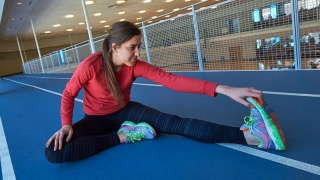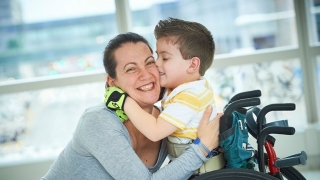Lordosis
What is lordosis?
Lordosis is a type of spinal curve in which the normal inward curve of the lower back is exaggerated. This excessive curve can make the buttocks more prominent and give the child a "swayback" appearance.
A normal spine, when viewed from behind appears straight. However, a spine affected by lordosis shows evidence of a curvature of the back bones (vertebrae) in the lower back area, which is visible from the side.

Causes
The cause of lordosis has been linked to achondroplasia and spondylolisthesis. However, lordosis may be associated with poor posture, a congenital (present at birth) problem with the vertebrae, neuromuscular problems, back surgery, pelvis, or a hip problem.
Symptoms
Each child may experience symptoms differently. The major clinical feature of lordosis is a prominence of the buttocks. Symptoms will vary depending if lordosis occurs with other defects, such as muscular dystrophy, developmental dysplasia of the hip, or neuromuscular disorders.
Back pain, pain down the legs, and changes in bowel and bladder habits are not commonly associated with lordosis. A child experiencing these types of symptoms requires immediate medical evaluation by a doctor.
The symptoms of lordosis may resemble other spinal conditions or deformities, or may be a result of an injury or infection. Always consult your child's doctor for a diagnosis.
Diagnosis
The doctor makes the diagnosis of lordosis with a complete medical history of the child, physical examination, and diagnostic tests. Your child's doctor obtains a complete prenatal and birth history of the child and asks if other family members are known to have lordosis.
Diagnostic procedures may include:
- X-rays. This diagnostic test uses invisible electromagnetic energy beams to produce images of internal tissues, bones, and organs onto film. This test is used to measure and evaluate the curve. With the use of a full-spine X-ray, the doctor or radiologist measures the angle of the spinal curve. A determination for treatment can often be made based on this measurement.
- Bone scans. Bone scans are a nuclear imaging method to evaluate any degenerative and/or arthritic changes in the joints; to detect bone diseases and tumors; to determine the cause of bone pain or inflammation. This test is to rule out any infection or fractures.
- Magnetic resonance imaging (MRI). This diagnostic procedure uses a combination of large magnets and a computer to produce detailed images of organs and structures within the body. This test is done to rule out any associated abnormalities of the spinal cord and nerves.
- Computed tomography (CT) scan. This diagnostic imaging procedure uses a combination of X-rays and computer technology to produce horizontal, or axial, images (often called slices) of the body. A CT scan shows detailed images of any part of the body, including the bones, muscles, fat, and organs. CT scans are more detailed than general X-rays.
- Blood tests
Early detection of lordosis is important for successful treatment. Pediatricians or family doctors, and even some school programs, routinely look for signs that lordosis may be present.
Treatment
Specific treatment for lordosis will be determined by your child's doctor based on:
- Your child's age, overall health, and medical history
- The underlying cause of the lordosis
- The extent of the condition
- Your child's tolerance for specific medications, procedures, or therapies
- Expectations for the course of the condition
- Your opinion or preference
The goal of treatment is to stop the progression of the curve and minimize deformity. Management of lordosis will depend on the cause of the lordosis. Simple exercises may be sufficient if lordosis is associated with poor posture. However, lordosis occurring as a result of a hip problem may be treated as a part of the hip problem.
Long-term outlook
The management of lordosis is individualized for each child depending on his or her age, amount of curvature, and amount of skeletal growth remaining. Lordosis will require frequent examinations by your child's doctor to monitor the curve as your child grows and develops. Early detection is important.

